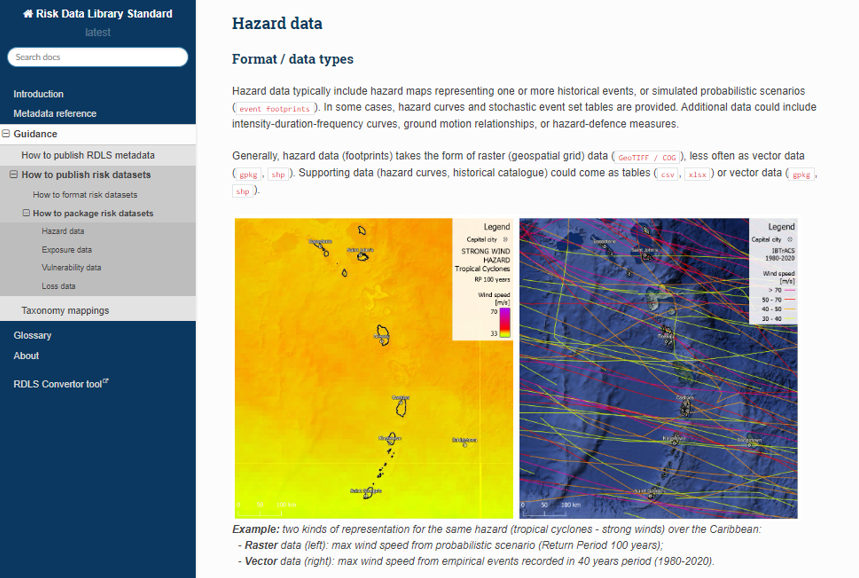This article first appeared on the Data Blog of the World Bank
The Global Facility for Disaster Reduction and Recovery (GFDRR) releases the Risk Data Library Standard (RDLS), an open data standard to make it easier to publish, access, share, and use quality disaster and climate risk data.

From a data point of view, achieving a world free of poverty on a livable planet can mean searching for the best flood hazard map to be combined with the right poverty indicators. Yet, the production of and access to disaster risk information, especially in the most vulnerable and poorest countries, remains a challenge. There is a need for a common language that would facilitate better collaboration on and with risk data.
Solving the puzzle of risk data
In 2022 alone, natural hazards caused $275 billion in economic losses according to Swiss Re company. Yet, that type of figure only scratches the surface of how disasters impact the poorest communities. Beyond financial losses and damages, disaster risk assessments must also incorporate socio-economic and non-economic data to better assist the most vulnerable.
Traditionally, the insurance industry has been at the forefront of producing disaster and climate risk figures. By combining hazard scenarios with population and infrastructure data through catastrophe models, insurance companies would provide estimates of financial losses to their clients. But in the last decade, humanitarian and development organizations such as the World Bank have increasingly invested in disaster risk assessments, too.
The data required for assessing disaster risk can generally be divided into three categories: hazard, exposure, and vulnerability. To date there is no widely accepted approach for storing, sharing, and discovering such information. In practice, this situation introduces a significant amount of friction in efforts to quantify and manage disaster risk.
A new open data standard
Aware of the issue, a team at the Global Facility for Disaster Reduction and Recovery (GFDRR) has been coordinating research and development that led to the concept of the Risk Data Library, a data toolkit to manage online collections of risk data. At the heart of that effort is the Risk Data Library Standard (RDLS).
The RDLS is essentially an open data standard for describing disaster risk information such as hazard, exposure, vulnerability, and loss datasets used in climate and disaster risk assessments. It also provides guidance on how to format and publish risk data itself and comes with conversion and validation tools to facilitate its adoption.
The standard can handle multiple types of disaster and climate risk studies, either monetary or non-monetary, using historical disaster events or probabilistic analysis. It is also designed to support different types of exposure and vulnerability functions for buildings infrastructure, people, and natural assets.
Practical benefits
In practice, the value of the RDLS will depend on the number of users who adopt it. Thankfully, it can respond to many different needs:
- Students and academics can use the RDLS to improve discoverability and reproducibility of their research in the field and make it easier to publish their results.
- Risk modelers can adopt the RDLS to compare and adapt risk models produced in high-income countries to make them better fit with lower-income context.
- Policy analysts can learn from the RDLS which disaster and climate risk studies have been conducted for a given location and find out about the hazard information gaps in the area.
- Software developers may use the RDLS to develop specific risk data tools, for instance, to help with the generation of localized vulnerability indicators for buildings or population.
In the end, the real benefit of the RDLS will reside in the number of people who did not suffer from a disaster because someone, somewhere, was able to take a closer look at the data.
A collection of disaster risk assessment data compliant with the Risk Data Library Standard available on the Development Data Hub/Data Catalog of the World Bank.

Who is behind the RDLS?
The concept of the Risk Data Library initially emerged from a consultation led by GFDRR and the United Kingdom’s Department for International Development (DFID) that resulted in the publication of the report “Solving the Puzzle.”
An initial version was developed as a database schema with principal contributions from the Global Earthquake Model (GEM) Foundation, UCL Epicentre, and the British Geological Survey (BGS). Since 2022, a grant from the Swiss Re Foundation has been supporting the development and promotion of the schema as an open data standard.
The RDLS is currently overseen by a steering committee of disaster risk experts. Moving forward, it will continue to be developed and maintained by the Digital Earth team at GFDRR.
Early adopters
Within the World Bank, the Risk Data Library has already gained traction among staff and consultants, with more than 100 datasets now available in the dedicated and growing collection of the World Bank’s data catalog. It is promoted for any new flood risk assessments and used by Risk Data Fellows recruited from climate-vulnerable countries.
Beyond the World Bank, initial developers from the Global Earthquake Model Foundation and UCL Epicentre are actively working on specific components of the Risk Data Library, including exposure and vulnerability schemas. There is also work underway to use RDLS metadata as part of the Open Data Standards Initiative curated by the OASIS Loss Modelling Framework.
We invite you to be an early adopter of the Risk Data Library Standard, too, and encourage your contributions to our new common language on risk data.
For more information on how to adopt the Risk Data Library Standard or provide feedback, please visit https://docs.riskdatalibrary.org/ or email contact@riskdatalibrary.org.






